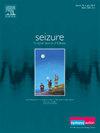Cardiac arrhythmias in patients with focal and generalised epilepsy undergoing ambulatory electroencephalographic and electrocardiographic monitoring
IF 2.8
3区 医学
Q2 CLINICAL NEUROLOGY
引用次数: 0
Abstract
Background
Epilepsy may be associated with cardiac arrhythmias. The specific incidence and types of cardiac arrhythmias in different forms of epilepsy is not clearly defined.
Methods
We evaluated patients aged 16 years or older referred for continuous home-based ambulatory video–electroencephalographic(EEG)–electrocardiographic(ECG) monitoring (AVEEM) across 24 sites in Australia between 2020 and 2023. Data collected included baseline demographics, type of epilepsy according to EEG findings, and cardiac arrhythmias (ictal and non-ictal) during monitoring. Logistic regression was used to evaluate association between potential risk factors and cardiac arrhythmias.
Results
A total of 866 patients with focal epilepsy and 274 with generalised epilepsy were identified who underwent AVEEM. Patients with generalised epilepsy were younger (median age 24 years versus 43 years) and more likely female (69 % versus 55 %) compared with focal epilepsy. Patients with focal epilepsy had more cardiac arrhythmias (279/866; 32 %) compared with generalised epilepsy (40/274; 15 %; p = 0.04). In patients with focal epilepsy, there were more cardiac arrhythmias observed in temporal lobe epilepsy (238/688; 35 %) compared with extra-temporal lobe focal epilepsy (16/82; 20 %; p = 0.006). However, on multivariable analysis only increased age (p < 0.001) remained a significant predictor of increased cardiac arrhythmias. Right or left sided origin of focal epilepsy was not associated with a difference in cardiac arrhythmias (p = 0.63).
Conclusions
Patients with focal epilepsy had more cardiac arrhythmias compared with generalised epilepsy that was explained by increased age. This study demonstrates feasibility of longer term ambulatory EEG-ECG monitoring in the outpatient setting for real-world assessment of cardiac arrhythmias in patients with epilepsy.
局灶性和全身性癫痫患者的心律失常进行动态脑电图和心电图监测
背景:癫痫可能与心律失常有关。不同类型癫痫中心律失常的具体发生率和类型尚未明确界定。方法:我们评估了2020年至2023年间澳大利亚24个地点的16岁或以上的连续家庭动态视频脑电图(EEG) -心电图(ECG)监测(AVEEM)患者。收集的数据包括基线人口统计数据、脑电图结果显示的癫痫类型以及监测期间的心律失常(突发和非突发)。采用Logistic回归评价潜在危险因素与心律失常之间的关系。结果局灶性癫痫866例,广泛性癫痫274例,均行AVEEM。与局灶性癫痫患者相比,全身性癫痫患者更年轻(中位年龄为24岁对43岁),更可能是女性(69%对55%)。局灶性癫痫患者心律失常发生率更高(279/866;32%)与全身性癫痫(40/274;15%;P = 0.04)。局灶性癫痫患者中,颞叶癫痫患者心律失常发生率更高(238/688;35%)与颞叶外局灶性癫痫(16/82;20%;P = 0.006)。然而,在多变量分析中,只增加了年龄(p <;0.001)仍然是心律失常增加的重要预测因子。局灶性癫痫的右侧或左侧起源与心律失常的差异无关(p = 0.63)。结论局灶性癫痫患者心律失常发生率高于全身性癫痫患者,与年龄增长有关。本研究证明了在门诊进行长期动态EEG-ECG监测以评估癫痫患者心律失常的可行性。
本文章由计算机程序翻译,如有差异,请以英文原文为准。
求助全文
约1分钟内获得全文
求助全文
来源期刊

Seizure-European Journal of Epilepsy
医学-临床神经学
CiteScore
5.60
自引率
6.70%
发文量
231
审稿时长
34 days
期刊介绍:
Seizure - European Journal of Epilepsy is an international journal owned by Epilepsy Action (the largest member led epilepsy organisation in the UK). It provides a forum for papers on all topics related to epilepsy and seizure disorders.
 求助内容:
求助内容: 应助结果提醒方式:
应助结果提醒方式:


